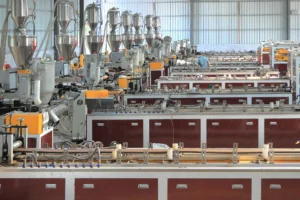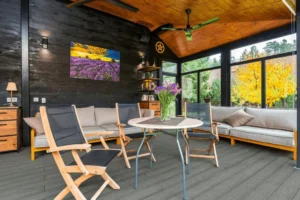What is Flame Retardant PVC-based WPC?
Wood-plastic composites (WPC) have become an integral part of daily life, gaining popularity due to their versatility and performance. In recent years, the demand for PVC-based wood-plastic composites has been steadily increasing, primarily due to their superior appearance and better flame-retardant properties. These materials have been widely applied in interior decoration and furniture industries. However, PVC-based WPC pose significant safety concerns during combustion, as they release toxic smoke that can increase the risk of casualties in case of a fire. Therefore, improving the flame retardancy and smoke suppression performance of PVC-based WPC has become critical.
The Need for Enhanced Flame Retardancy and Smoke Suppression
As the demand for PVC-based WPC rises, enhancing their flame-retardant properties is paramount. Current domestic and international patents and technologies have struggled to meet the high-end market’s demands, which require materials to be aesthetically pleasing, strong, flame-retardant, and cost-effective. Thus, the development of low-cost, high-strength flame-retardant WPC has become a necessity. Such materials have good market potential and could significantly increase the added value of WPC applications.

New Flame Retardant, Smoke Suppressive PVC-Based WPC
A new high-efficiency flame-retardant and smoke-suppressive PVC-based wood-plastic composite has been developed. This composite material is made from the following ingredients:
– SG-8 PVC Resin: 100 parts
– Rubberwood Powder: 40 parts
– Acrylonitrile-Butadiene-Styrene (ABS) Copolymer Impact Modifier: 3 parts
– Aluminate Coupling Agent: 0.2 parts
– Stearic Acid Lubricant: 0.5 parts
– Zinc Stearate Heat Stabilizer: 5 parts
– Chlorinated Polyethylene: 2 parts
– Zinc Borate Smoke Suppressant: 5 parts
Preparation Process
The preparation of this material involves the following steps:
1. Weighing and Mixing:
All materials are measured according to the specified quantities.
2. High-Speed Pre-Mixing:
The materials are placed in a high-speed mixer and pre-mixed at a speed of 1400 RPM for 6 minutes to create a dry blend.
3. Melt Blending:
The dry blend is then placed in a torque rheometer, where it is mixed at 175°C for 8 minutes to form a homogenous material.
4. Hot Press Molding:
The mixed material is hot-pressed into shape using a platen vulcanizer, and the final product is then cut using a universal cutting machine.
Advantages of the New Material
This newly developed PVC-based WPC exhibits several advantages over existing technologies, including:
– Low Cost: The material is cost-effective, making it accessible for mass production.
– Low Smoke and Low Toxicity: It significantly reduces the release of toxic smoke during combustion, improving safety in fire situations.
– High Mechanical Performance: The composite offers improved strength and durability.
– High Flame Retardancy: The flame-retardant properties are enhanced, reducing the risk of fire damage.
Market Trends and Future Prospects
While research into flame retardants and smoke suppression for WPC has been widely explored, some of the technologies are still in the experimental stage and have not yet reached industrial-scale production. However, with continuous advancements in the development of new flame-retardant PVC-based wood-plastic composites, these materials are expected to rapidly evolve and become an essential part of industries where safety and performance are a priority, including construction, furniture manufacturing, and outdoor applications.
The development of high-efficiency flame-retardant and smoke-suppressive PVC WPC not only addresses the critical need for enhanced fire safety but also represents a significant opportunity to increase the value and versatility of wood-plastic composites, offering both environmental and economic benefits.
Trending Reading
What Are the Differences Between the WPC Board and PVC Board?
[2024 Update] How Long Does WPC Decking Last?











